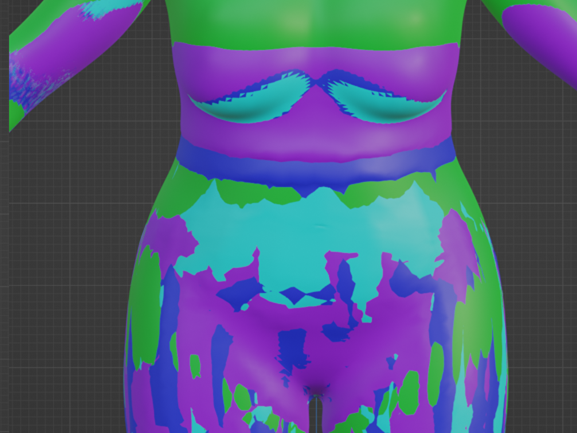Investigation of the tissue displacement through textile pressure on soft avatar in Browzwear’s VStitcher software
DOI:
https://doi.org/10.25367/cdatp.2024.5.p151-160Keywords:
soft tissue simulation, soft body physics, garment fit, tissue displacementAbstract
Nowadays, soft avatars are used in various fields to simulate the behavior of human soft tissues in different applications. Likewise, they are also utilized in the garment industry in order to achieve a realistic testing of the fit and functionality of tight-fitting clothing. Therefore it is important that avatars in CAD programs for clothing conform to the mechanical properties of human soft tissue. The accuracy of the avatars' properties in simulating the change in shape of human tissue is crucial here, which is caused by the contact pressure that compressive or tight-fitting garments exert onto the body. In this study, Browzwear’s VStitcher soft avatar Sofia was investigated and different body shapes resulting from being influenced by a legging with different levels of negative ease values were compared with non-affected natural avatar body shape. The examination of the soft avatar simulation shows that although a fast estimation of the tissue displacement can be predicted, there are some shape changes limitations compared to the natural behavior of human soft tissue.
References
Kaiser, C. Vorgehensmodell zum Aufbau einer validierten Simulationsumgebung zur Bestimmung des durch Kompressionsstrümpfe induzierten Kontaktdrucks als Basis für eine virtuelle Funktionsanalyse; LIT Verlag Dr. W. Hopf, Berlin, 2019.
Browzwear, https://go.browzwear.com/2022.2-vstitcher-lotta-edition-soft-avatar-sign-up.
Lohmann, S. Eigenschaften biologischer Materialien zur Simulation menschlicher Bewegung: funktionell-anatomische Grundlagen und Materialeigenschaften zur Erstellung dreidimensionaler Körpermodelle im Computer. Ph.D. thesis, Konstanz University, Germany, 2005.
Endler F. Einführung in die Biomechanik und Biotechnik des Bewegungsapparates. In Orthopädie in Praxis und Klinik, Bd. I; Witt, A. N.; Rettig, H.; Schlegel, K. F.; Hackenbroich, M.; Hupfauer, W., Eds.; Thieme Verlag, Stuttgart, 1980.
Zeng, W.; Mukherjee, S.; Caudillo, A.; Forman, J; Panzer, M. B. Evaluation and validation of thorax model responses: a hierarchical approach to achieve high biofidelity for thoracic musculoskeletal system. Frontiers in Bioengineering and Biotechnology 2021, 9, 712656.
Harih, G.; Kalc, M.; Vogrin, M.; Fodor-Mühldorfer, M. Finite element human hand model: Validation and ergonomic considerations. International Journal of Industrial Ergonomics 2021, 85, 103186.
Delingette, H.; Ayache, N. Soft tissue modeling for surgery simulation. Handbook of Numerical Analysis 2004, 12, 453-550.
Xu, Z.; Chen, N.; Wang, B.; Yang, J.; Liu, H.; Zhang, X.; Li, Y.; Liu, L.; Wu, Y. Creation of the biomechanical finite element model of female pelvic floor supporting structure based on thin-sectional high-resolution anatomical images. Journal of Biomechanics 2023, 146, 111399.
Moaveni, S. Finite element analysis theory and application with ANSYS, 3rd Ed. Pearson Education India; 2011.
Liu, G. R.; Quek, S. S. The finite element method: a practical course. Butterworth-Heinemann, 2013.
Schiehlen, W. Advanced multibody system dynamics: simulation and software tools. Springer Science & Business Media, 2013.
Dankowicz H. Multibody mechanics and visualization. Springer Science & Business Media, 2005.
Freutel, M.; Schmidt, H.; Dürselen, L.; Ignatius, A.; Galbusera, F. Finite element modeling of soft tissues: material models, tissue interaction and challenges. Clinical Biomechanics 2014, 29(4), 363-372.
Holzapfel, G. A. Biomechanics of soft tissue. The Handbook of Materials Behavior Models 2001, 3(1), 1049-1063.
Müller, M.; Keiser, R.; Nealen, A.; Pauly, M.; Gross, M.; Alexa, M. Point based animation of elastic, plastic and melting objects. In Proceedings of the 2004 ACM SIGGRAPH/Eurographics symposium on Computer animation 2004; pp. 141-151.
Bridson, R. Fluid simulation for computer graphics. AK Peters/CRC Press, 2015.
Fedkiw, R.; Stam, J.; Jensen, H. W. Visual simulation of smoke. In Proceedings of the 28th annual conference on Computer graphics and interactive techniques 2001, pp. 15-22.
Jiang, C.; Gast, T.; Teran, J. Anisotropic elastoplasticity for cloth, knit and hair frictional contact. ACM Transactions on Graphics (TOG) 2017, 36(4), 152.
Romero, S.; Romero, L. F.; Zapata, E. L. Fast cloth simulation with parallel computers. In Euro-Par 2000 Parallel Processing: 6th International Euro-Par Conference, Munich, Germany, August 29-September 1, 2000, Proceedings 6 2000, Springer Berlin Heidelberg; pp. 491-499.
CLO Virtual Fashion LLC., CLO, 2022. https://www.clo3d.com/en/ (accessed 29-11-2022).
Ailabouni, M. BROWZWEAR Help Center – Physics Reference, Browzwear, 02-2023. https://help.browzwear.com/hc/en-us/articles/4921405457305-Physics-Reference (accessed 06-03-2023).
Bauerfeind, 2023. https://www.bauerfeind-sports.com/de/Produktlinien/Compression-Sleeves/Sports-Compression-Sleeves-Upper-Leg/p/YPBF_SPB_SCSLEEVUL (accessed 06-03-2023).
DIN-Normenausschuss Materialprüfung, Sports Textiles – Measurement of Compression and Material Properties (Pressure Properties); DIN SPEC 4868; DIN Media GmbH, 2020.
Under Armour® Inc. 2024, https://www.underarmour.de/de-de/c/damen/sport/laufen/ (accessed 06-03-2023).
Browzwear Help Center – Soft Avatar Overview, Browzwear, 02-2023. https://help.browzwear.com/hc/en-us/articles/13185391291673-Soft-Avatars-Overview (accessed 06-03-2023).
Lüllmann-Rauch, R.; Asan, E. Taschenlehrbuch Histologie. Georg Thieme Verlag, Stuttgart, 2015.
Wex, C.; Arndt, S.; Stoll, A.; Bruns, C.; Kupriyanova, Y. Isotropic incompressible hyperelastic models for modelling the mechanical behaviour of biological tissues: a review. Biomedical Engineering/Biomedizinische Technik 2015, 60(6), 577-592.
Lapeer, R. J.; Gasson, P. D.; Karri, V. A hyperelastic finite-element model of human skin for interactive real-time surgical simulation. IEEE Transactions on Biomedical Engineering 2010, 58(4), 1013-1022.

Downloads
Published
How to Cite
Issue
Section
License
Copyright (c) 2024 Elena Alida Brake, Yordan Kyosev, Katerina Rose

This work is licensed under a Creative Commons Attribution 4.0 International License.





